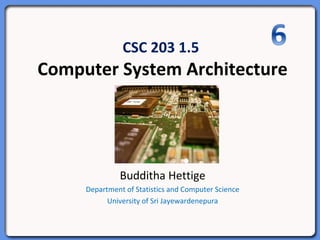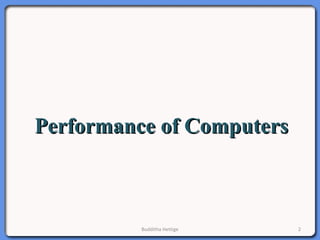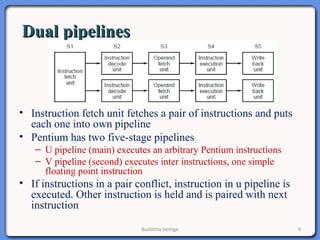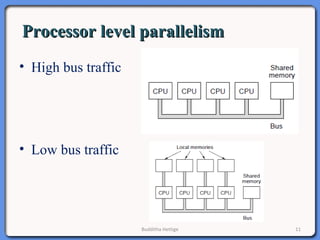Computer System Architecture Lecture Note 6: hardware performance
- 1. CSC 203 1.5 Computer System Architecture Budditha Hettige Department of Statistics and Computer Science University of Sri Jayewardenepura
- 2. Performance of ComputersPerformance of Computers Budditha Hettige 2
- 3. Improving Performance of ComputersImproving Performance of Computers • Increasing clock speed – Physical limitation (Need new hardware) • Parallelism (Doing more things at once) – Instruction-level parallelism • Getting more instruction per second – Processor-level parallelism • Having multiple CPUs working on the same problem Budditha Hettige 3
- 4. Instruction-level parallelismInstruction-level parallelism • Pipelining – Instruction execution speed is affected by time taken to fetch instruction from memory – Early Computers fetch instructions in advance and stored in registers (Prefetch buffer) • Prefetching divides instruction execution into two parts – Fetching – Actual execution – Pipelining divides instruction in to many parts; each handled by different hardware and can run in parallel Budditha Hettige 4
- 5. Pipelining examplePipelining example • Packaging cakes – W1: Place an empty box on the belt every 10 second – W2: Place the cake in the empty box – W3: Close and seal the box – W4: Label the box – W5: Remove the box and place it in the large container Budditha Hettige 5
- 6. Computer PipelinesComputer Pipelines • S1: Fetch instruction from memory and place it in a buffer until it is needed • S2: Decode the instruction; determine it type and operands it needs • S3: locate the fetch operands from memory (or registers) • S4: Execute instruction • S5: Write back result in a register Budditha Hettige 6
- 7. ExampleExample T - Cycle time N - Number of stages in the pipeline Latency: Time taken to execute an instruction = N x T Processor Bandwidth: No. of MIPS the CPU has = 1000 MIPS T Budditha Hettige 7
- 8. Processor - pipeline depthProcessor - pipeline depth Budditha Hettige 8
- 9. Dual pipelinesDual pipelines • Instruction fetch unit fetches a pair of instructions and puts each one into own pipeline • Pentium has two five-stage pipelines – U pipeline (main) executes an arbitrary Pentium instructions – V pipeline (second) executes inter instructions, one simple floating point instruction • If instructions in a pair conflict, instruction in u pipeline is executed. Other instruction is held and is paired with next instruction Budditha Hettige 9
- 10. Superscalar architectureSuperscalar architecture • Single pipeline with multiple functional units Budditha Hettige 10
- 11. Processor level parallelismProcessor level parallelism • High bus traffic • Low bus traffic Budditha Hettige 11
- 12. Measuring PerformanceMeasuring Performance Budditha Hettige 12
- 13. Moore’s lawMoore’s law • Describes a long-term trend in the history of computing hardware • Defined by Dr. Gordon Moore during the sixties. • Predicts an exponential increase in component density over time, with a doubling time of 18 months. • Applicable to microprocessors, DRAMs , DSPs and other microelectronics. Budditha Hettige 13
- 15. Moore's Law and PerformanceMoore's Law and Performance • The performance of computers is determined by architecture and clock speed. • Clock speed doubles over a 3 year period due to the scaling laws on chip. • Processors using identical or similar architectures gain performance directly as a function of Moore's Law. • Improvements in internal architecture can yield better gains than predicted by Moore's Law. Budditha Hettige 15
- 17. Measuring PerformanceMeasuring Performance • Execution time: – Time between start and completion of a task (including disk accesses, memory accesses ) • Throughput: – Total amount of work dome a given time Budditha Hettige 17
- 18. Performance of a ComputerPerformance of a Computer Two Computer X and Y; Performance of (X) > Performance of (Y) Execution Time (Y) > Execution Time (X) Budditha Hettige 18
- 19. Performance of difference 2 ComputerPerformance of difference 2 Computer X is n Time faster than Y Budditha Hettige 19
- 20. CPU TimeCPU Time • Time CPU spends on a task • User CPU time – CPU time spent in the program • System CPU time – CPU time spent in OS performing tasks on behalf of the program Budditha Hettige 20
- 21. CPU Time (Example)CPU Time (Example) • User CPU time = 90.7s • System CPU time 12.9s • Execution time 2m 39 s 159s • % of CPU time = User CPU Time + System CPU Time X 100 % Execution time Budditha Hettige 21
- 22. CPU TimeCPU Time % CPU time = (90.7 + 12.9 ) x 100 159 = 65 % Budditha Hettige 22
- 23. Clock RateClock Rate • Computer clock runs at the constant rate and determines when events take place in the hardware Clock Rate = 1 Clock Cycle Budditha Hettige 23
- 24. Amdahl’s lawAmdahl’s law • Performance improvement that can be gained from some faster mode of execution is limited by fraction of the time the faster mode can be used Budditha Hettige 24
- 25. Amdahl’s lawAmdahl’s law • Speedup depends on – Fraction of computation time in original machine that can be converted to take advantage of the enhancement (Fraction Enhanced) – Improvement gains by enhanced execution mode (Speedup Enhanced) Budditha Hettige 25
- 26. ExampleExample Total execution time of a Program = 50 s Execution time that can be enhanced = 30 s FractionEnhanced = 30 /50 = 0.6 Budditha Hettige 26
- 28. ExampleExample Normal mode execution time for some portion of a program = 6s Enhances mode execution time for the same program = 2s Speedup Enhanced = 6/2 = 3 Budditha Hettige 28
- 29. Execution TimeExecution Time Budditha Hettige 29
- 30. ExampleExample • Suppose we consider an enhancement to the processor of a server system used for Web serving. New CPU is 10 times faster on computation in Web application than original CPU. Assume original CPU is busy with computation 40% of the time and is waiting for I/O 60% of time. What is the overall speedup gained from enhancement? Budditha Hettige 30
- 32. RemarkRemark • If an enhancement is only usable for fraction of a task, we cannot speedup by more than Budditha Hettige 32
- 33. ExampleExample • A common transformation required in graphics engines is square root. Implementation of floating- point (FP) square root vary significantly in performance, especially among processors designed graphics • Suppose FP square root (FPSQR) is responsible for 20% of execution tine of a critical graphics program • Design alternative 1. Enhance EPSQR hardware and speed up this operation by a factor of 10 2. Make all FP instruction run faster by a factor of 1.6 Budditha Hettige 33
- 34. ExampleExample • FP instruction are responsible for a total of 50% of execution time. Design team believes they can make all fp instruction run 1.6 times faster with same effort as required for fast square root. Compare these two design alternatives Budditha Hettige 34
- 36. CPU performance equationCPU performance equation CPU time = CPU clock cycles for a program x Clock cycle time = CPU clock cycles / Clock rate Budditha Hettige 36
- 37. ExampleExample A program runs in 10s on computer A having 400 MHz clock. A new machine B, which could run the same program in 6s, has to be designed. Further, B should have 1.2 times as many clock cycles as A. What should be the clock rate of B? Budditha Hettige 37
- 39. CPU Clock CyclesCPU Clock Cycles CPI (clock cycles per instruction) average no. of clock cycles each instruction takes to execute IC (instruction count) no. of instructions executed in the program CPU clock cycles = CPI x IC Note: CPI can be used to compare two different implementations of the same instruction set architecture (as IC required for a program is same) Budditha Hettige 39
- 40. ExampleExample • Consider two implementations of same instruction set architecture. For a certain program, details of time measurements of two machines are given below • Which machine is faster for this program and by how much? Budditha Hettige 40
- 42. Measuring componentsMeasuring components of CPU performance equationof CPU performance equation • CPU Time: by running the program • Clock Cycle Time: published in documentation • IC: by a software tools/simulator of the architecture ((more difficult to obtain) • CPI: by simulation of an implementation (more difficult to obtain) Budditha Hettige 42
- 43. CPU clock cyclesCPU clock cycles Suppose n different types of instruction Let ICi – No. of times instruction i is executed in a program CPIi – Avg. no. of clock cycles for instruction i Budditha Hettige 43
- 44. ExampleExample Suppose we have made the following measurements: – Frequency of FP operations (other than FPSQR) = 25% – Average CPI of FP operations = 4.0 – Average CPI of other instructions = 1.33 – Frequency of FPSQR= 2% – CPI of FPSQR = 20 Design alternatives: 1. decrease CPI of FPSQR to 2 2. decrease average CPI of all FP operation to 2.5 Compare these two design alternatives using CPU performance equation Budditha Hettige 44
- 45. AnswersAnswers • Note that only CPI changes; clock rate; IC remain identical Budditha Hettige 45
- 46. MIPS as a performance measureMIPS as a performance measure Budditha Hettige 46
- 47. ProblemsProblems MIPS as a performance measure • MIPS is dependant on instruction set – difficult to compare MIPS of computers with different instruction sets • MIPS can vary inversely to performance Budditha Hettige 47
- 48. MFLOPS as a performance measureMFLOPS as a performance measure Budditha Hettige 48
- 49. ProblemsProblems MIPS as a performance measure • MFLOPS is not dependable – Cray C90 has no divide instructions while Pentium has • MFLOPS depends on the mixture of fast and slow floating point operations – add (fast) and divide (slow) operations Budditha Hettige 49

















































